
At your local tropical fish store, you can find a particularly wonderful creature called an Elephant Nose fish, or more properly, Gnathonemus petersii, a member of the Mormyrid family.

Besides the obvious visual interest of the animal, there is another fascinating aspect to it -- it emits pulses of electricity into the water, with which it locates food, other fish, and potential mates.
It is easy to listen in on these electrical signals with simple inexpensive equipment, such as a piezoelectric earphone, or a small amplifier.
A piezoelectric earphone is a simple device I have described earlier (in the crystal radio section. You can get them at Radio Shack in their crystal radio kits, or you can get them from our catalog. They are very sensitive to small electrical signals, and so they are perfect for detecting the electrical signals from the Elephant Nose fish, and converting them into sound you can hear.
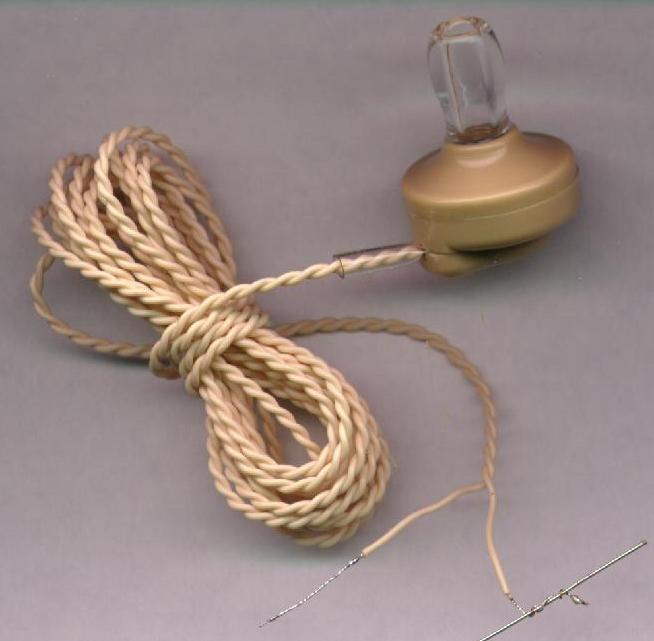
To listen in on the fish, simply put one wire from the earphone into the water at one side of the fishtank, and the other wire into the water at the other side of the fishtank, and put the earphone up to your ear.
If you click here you can hear what it sounds like.
If the fish is sitting still, the electrical pulses will be infrequent. But as the fish moves around, it increases the frequency of the pulses, until it is almost a buzz. It does this because as it moves faster, it needs more information about its surroundings in order to navigate. It uses the pulses like radar, to avoid obstacles, to find food, to avoid predators, and to locate other members of its species.
To enable an entire room to hear the electric fish, you need an amplifier. A stero system or boombox usually has an auxilliary input or phonograph input that you can use. Simply plug in a cable, and place the two wires in the tank like we did for the earphone.
In the photo below, I used a Radio Shack battery powered amplifier, which is small and easy to carry to a fish store. The amplifier is the Radio Shack part number 277-1008.
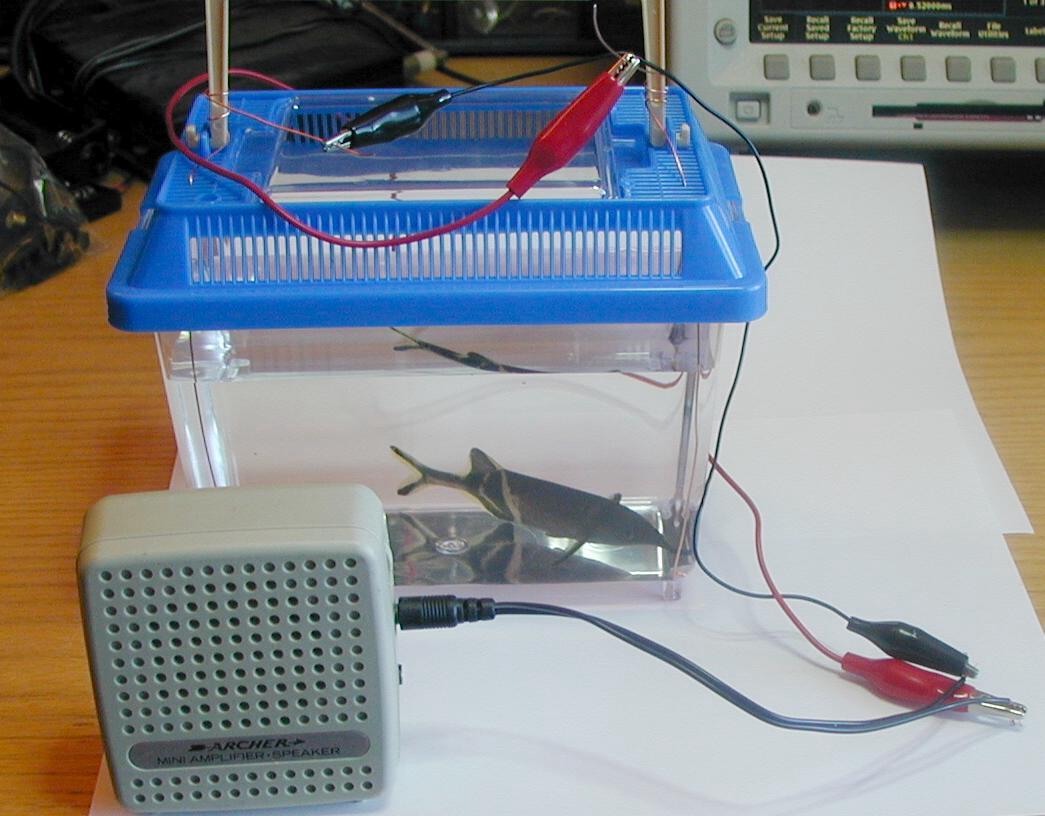
A plug goes into the input jack, and two alligator clips connect the wires from the plug to two bare copper wires running into the water on the left and right sides of the tank. The fish has been temprarily placed in a tiny tank to make photographing it easier. This tank is much too small to keep the fish in for more than about an hour.
With the amplifier, an entire room can easily hear the clicks and buzzes of the fish as it reacts to the environment.
The Nature of the Signal
With an oscilloscope or a computer sound card, we can capture the signal and look at a picture of it. The graph below is a snapshot of a bit of fast burst from the fish as it darted around the tank.
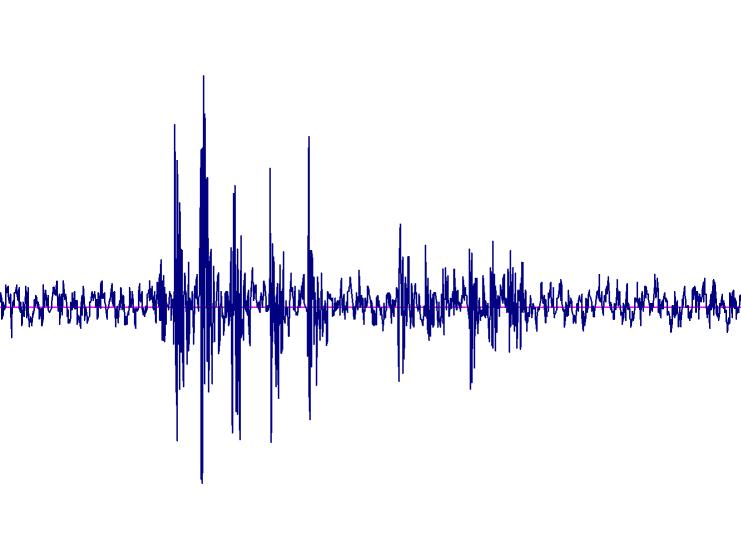
A closeup view of a single pulse is shown below.
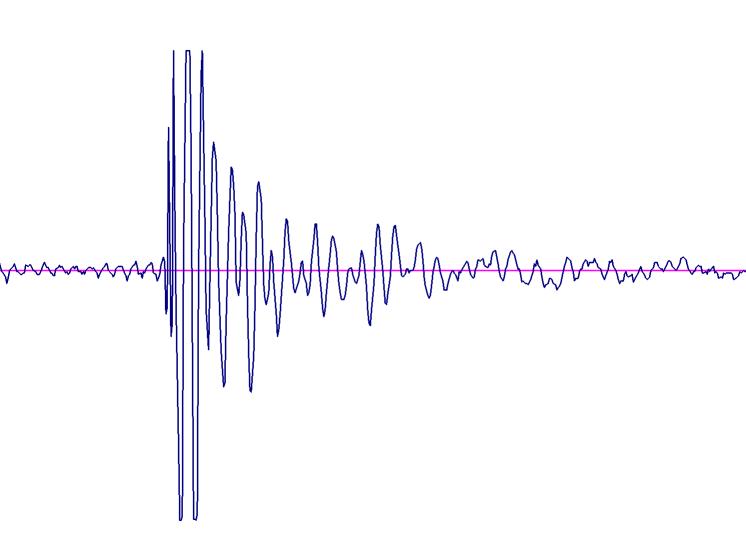
By simply putting a microphone up to the amplifier you can capture the sounds to a computer sound card and examine the graphs in detail. The graphs on this page were captured with an expensive oscilloscope, and then graphed with a spreadsheet program on a computer, but you don't need expensive equipment to get similar results. A sound card is more than enough to get all the details at these frequencies.
The Electric Organ Discharge
The electric organ of the Elephant Nose fish is clearly visible. It is the narrow reddish area connecting the "skirt" of the fish to the tail fins.
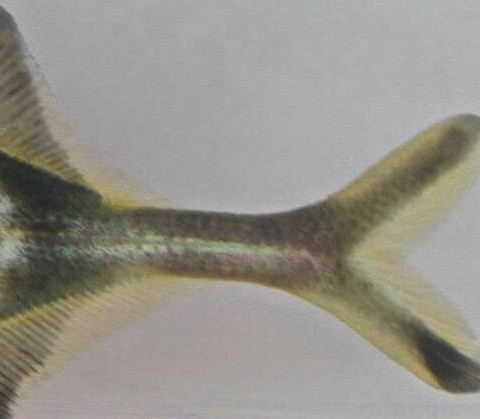
This is the organ that generates the signal. It is a modified muscle. To receive electric signals, either from other fish or from echoes of its own discharge, the Elephant Nose fish has three different types of receptors. These are the mormyromasts, the knollenorgans, and the ampullary receptors.
The mormyromasts are the organs that detect the echoes of the electric organ discharge. They are what enable the fish to navigate in murky water and find prey.
The knollenorgans detect the electric organ discharge of other elephant nose fish, and thus aid in communication and finding mates.
The ampullary receptors measure the low frequency electric fields emitted by other aquatic animals. Similar ampullary receptors are used by catfish and sharks.
Fish are very sensitive to tiny amounts of polutants in their environment. In some towns in Germany, the elephant nose fish is used to detect very small amounts of lead and trichloroethylene in the city's water supply. Because the electric discharges are so easy to detect and monitor with a computer, this method is cheaper than chemical tests, and can be done continuously. The number of discharges per minute drops off measurably when the levels of either pollutant rises, even at levels far below those considered dangerous.
Other Electric Fish
Some of the better known electric fish are the South American electric eelElectrophorus electricus, and the African electric catfish Malopterurus electricus. Another famous electric fish is the Mediteranean electric rayTorpedo torpedo. There is also an electric catfish from China, the Parasilurus asota. These are large fish with powerful electric discharge organs. They use the electric discharge to stun their prey and deter predators.
Other electric fish are more like the elephant nose fish, where the electric discharge is very small, and used for navigation and communication.
In the same family of fish (called mormyriform fish) as the elephant nose are several other species, such as Pollimyrus isidori, Gymnarchus niloticus, and Brienomyrus brachyistius.
Another family of weakly electric fish are the South American gymnotoidfish, such as Hypopomus artedi, Sternopygus, and Eigenmannia. WhileHypopomus produces pulses like the elephant nose fish, the others produce pure continuous sine waves.
The South American gymnotoid fish Eigenmannia virescens (the Glass Knifefish), Apteronotus leptorhynchus (the Brown Ghost Knife fish), andApteronotus albifrons (the Black Ghost Knife fish) are easy to find in tropical fish stores. They are all of the continuous sine wave type, rather than the pulse type.
For more information on electric fish, enter any of the scientific names mentioned above into an Internet search engine. There is an amazing amount of material available on these animals on the Web.